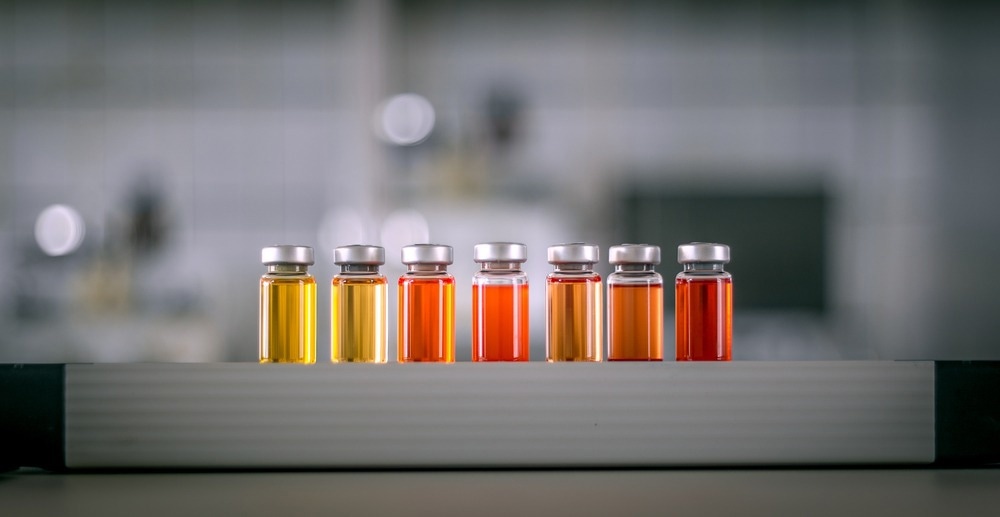Nanomaterials have created new avenues in biological and chemical analysis. Among various nanomaterials, quantum dots (QDs) serve as copper (Cu) sensors. Utilizing a microreactor enhances the stability of ions sensitivity in detection and shortens the detection time.

Study: Photothermal Waveguide-Directed Microreactor for Enhanced Copper Ion Detection from Quantum Dots. Image Credit: Tayfun Ruzgar/Shuttersdtock.com
In an article recently published in the journal ACS Applied Nano Materials, researchers developed a photothermal microreactor by integrating a microfluidic platform with a photothermal waveguide - graphene oxide (GO) - for enhanced detection of Cu+2 ions. Temperature gradient, vortex, intense vaper microbubbles, and microdroplets were simultaneously generated due to the improved photothermal effect of GO and the evanescent field of microfiber.
The constructed system could detect copper ions with high sensitivity in a sample as small as two microliters within 5 minutes. Furthermore, the detection limit was reduced three-fold compared to conventional detection methods. This photothermal microreactor is an eco-friendly, cheap, and highly efficient tool with hypotoxicity. It is a robust micro-sensing method for chemical analysis and environmental monitoring.
Analytical Methods for Cu+2 Ion Detection
Cu is a transition metal found in the human body and plays a crucial role in various biological processes like gene expression and metalloprotein composition. Its excess presence is harmful to human health, and superfluous Cu in water causes water pollution. Thus, a convenient tool for detecting Cu+2 ions is necessary for human health and the environment.
Graphite furnace atomic absorption spectrometry coupled with an electrochemical sensor and plasma mass spectrometer is a conventional analytical method for Cu+2 ion rapid detection. Nevertheless, the expensive devices, complex operation, low sensitivity, and large reagent consumption limit its applications. QDs with high sensitivity and quantum yields are utilized in the fluorescence sensing field for their application in optical sensors.
Miniaturizing the optical platforms offer great potential as compact devices. The multifunctional integrated systems have superior characteristics such as a handy operation process, low reagent consumption, and improved mass and heat transfer.
Despite the availability of integrated systems for Cu+2 ion detection, these detecting methods need a microlevel improvement to offer low reagent consumption and inexpensive instruments. Microreactors with a large surface area to volume ratio provide a conducive environment for processes like polymerization, nanoparticle (NP) synthesis, and sensing.
Droplet-based microreactors are miniaturized synthesis/analysis systems. The microreactor’s droplets serve as segmented flow reactors, wherein they use an immiscible fluid to partition the reagent phase into equal and distinct parts. Additionally, since the reaction mixture does not contact the channel walls, the products were not deposited on the surface, thus preventing the blockage and fouling due to NPs.
QDs for Cu+2 Ion Detection
In the present study, the researchers used the photothermal effect of GO as a photothermal waveguide (PTW) to achieve the microfluid’s optofluidic control and nano-/micron particles. They designed a novel photothermal microreactor (PMR) with enhanced Cu+2 ion detection.
The PMR utilized PTW and generated vortex fields and microbubbles with an enhanced photothermal effect. Microbubbles led to the formation of a high number of microdroplets of water-in-oil and induced their aggregation.
The QDs acted as fluorescent probes, gathered at the detection area, and interacted with Cu+2 ions due to vortex field trapping capacity, microdroplet’s large surface area, and accelerated molecular motion owing to increasing temperature.
Transmission electron microscopy (TEM) images revealed that the QDs had a diameter of 4.2 nanometers in the QD solution. Furthermore, after the reaction of QDs in PMR under 200 milliwatt for 5 minutes, the TEM images of these QDs at different magnifications showed a diameter of 9.7 nanometers in the QD solution. The Cu+2 ions complexed with oleylamine entered the QD solution and their interaction with QDs reduced them into elemental Cu, which covered the surface of QDs.
The PMR showed enhanced copper ion detection offering the merit of pollution-free and rapid detection with high selectivity, sensitivity, and hypotoxicity. Additionally, it showed prospects for quick on-site applications by integrating novel assays into a lab-on-a-chip.
Conclusion
In summary, the researchers fabricated a PMR system combined with QD NPs to detect the Cu+2 ions in a microliter sample. GO’s enhanced photothermal effect facilitated the absorption of the evanescent field and produced a thermal gradient to generate microdroplets, vapor microbubbles, and vortex fields.
The enhanced fluorescence with rapid detection and minimized reagent consumption was achieved through the vortex field’s NP trapping, the microdroplet’s large surface area, and the temperature-induced accelerated molecular motion.
Under a power of 200 milliwatts, 500 picometers Cu+2 ion detection was achieved in 5 minutes using a 2-microliter sample, which improved sensitivity and lower reagent consumption than other sensors.
The demonstrated method created a new avenue for directly detecting Cu+2 ions in solution with enhanced sensitivity. This method is anticipated to be suitable for nano-/micro scale environmental monitoring, chemical analysis, and disease diagnosis.
Reference
Li, Y., Wang, T., Li, Z., Yang, J., Yan, Z., Luo, F., et al. (2022) Photothermal Waveguide-Directed Microreactor for Enhanced Copper Ion Detection from Quantum Dots. ACS Applied Nano Materials. https://doi.org/10.1021/acsanm.2c01527
Disclaimer: The views expressed here are those of the author expressed in their private capacity and do not necessarily represent the views of AZoM.com Limited T/A AZoNetwork the owner and operator of this website. This disclaimer forms part of the Terms and conditions of use of this website.